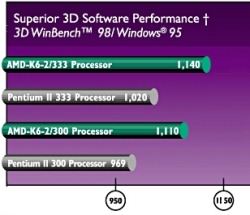| AMD vs. Intel: the AMD K6/2 350 by Ed "Lozhechnik" Reddy |
||||
|
Reviews Specs:
Intel and AMD Are you in the market to upgrade your CPU processing power? I was, and I did, but then I ran into a snag. I want to tell you about it, but before I get into it we'll need to cover some background. In the fast paced world of modern computer hardware, choice is everything. Do you prefer the EAX or the A3d standard? Is Glide or D3d your video interface of choice? Do you want a 24x or the latest 52X CD ROM? These decisions are standard fare for sound and video hardware. But if you bought your last computer more than two years ago, you likely didn't bother to ask the salesperson what type of CPU your new computer would have. Nowadays, we have a choice: go with good ol' bing, bing bing bing bing!, Intel processing power, or we can choose (no catchy melody available) AMD processing power. While Intel has been the dominant presence in CPU's for over a decade, recently AMD has been grabbing province after province on the frontiers of Intel's CPU marketshare empire. One reason for this must have been AMD's marketing premonition that new CPU sales would be driven by gamers; or rather, poor gamers who would need ever-more CPU processing power but who also have limited financial resources. A simple marketing strategy evolved: create a CPU with a cheaper price per Mhz than Intel's price per Mhz. Result: "Hello, people of the gamer province, I am Thor from AMD, we are now in control!" David and Goliath Not to say that the takeover was hostile. On the contrary, we gamers capitulated willingly. In fact, I was one of those willing inhabitants holding the city gates open. Besides, David seemed so much more friendly than old Goliath! Goliath (Intel), however, didn't just pack his weapons and go home. Of course not, he pulled in his elite Celeron brigade away from the notebook front to fight off the invading hordes of AMD barbarians. While the pimply faced kid fought the giant, I, being a proper citizen of the gaming provinces of AMD, even cheered on my captors (see article) as they battled with the oppressive Intel emperialists. "Vive la revolution!" I shouted as I ducked another stone. But that got boring, so I decided to sit down and take an objective look at living conditions here in AMD land. |
 As you can see from my system specifications at left, my test machine is an AMD K6/2 350MHz CPU with 3DNow! technology. I have been putting this AMD configuration through its paces for the past two months. I've used Rainbow 6 and Halflife with every CPU-unfriendly feature dialed up to the max in order to push the CPU to its limits. On the office productivity side of things, I maintained the abuse with some ridiculously large Access databases and Excel spreadsheet calculations (department budget "what ifs" ooohhh scary!). AMD Under the Microscope For me, Tom's Hardware> (THW) is my hardware bible, John Reynolds quibbles notwithstanding. I've always considered THW to be a good source of information on performance comparisons of motherboards, CPUs, video cards, and hard-drives. Recently, I found myself scouring the pages of THW in an attempt to find raw performance data for Intel's Celeron, PentiumII CPU's and AMD's latest offerings.  AMD's web site had comparison data of my AMD CPU vs. an Intel PentiumII 350MHz. A close examination of their facts left me to believe these data figures were as truthful as a Used Car salesman. They put their CPU against an Intel with a Nvidia video card (TNT?) and managed to squeak out better performance from the AMD. The performance-measuring tool was 3D WinBench - a poor application, in my opinion, for measuring true 3D gaming performance. Just to confirm my suspicions, I consulted my Bible of Hardware at THW and found some interesting data. Go to Page Two |
|||
|
Copyright © 1997 - 2000 COMBATSIM.COM, INC. All Rights Reserved.
Last Updated March 31st, 1999 |
||||

